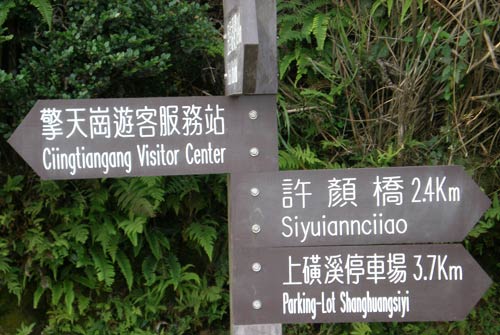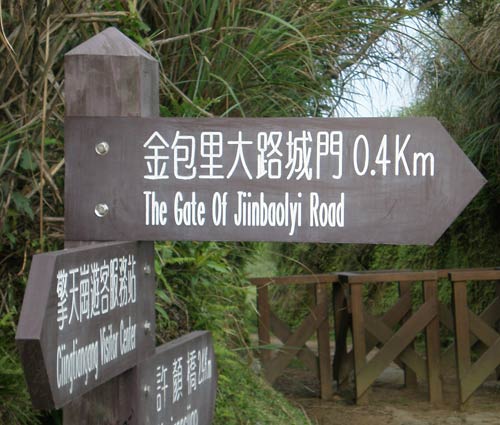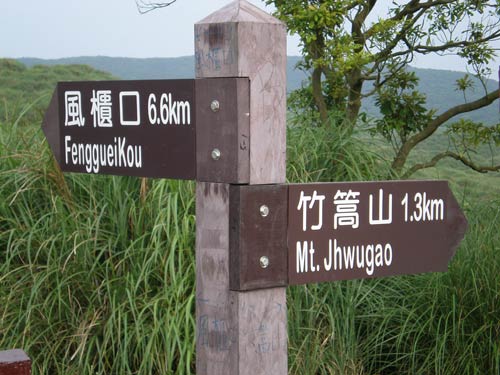The Qíngtiāngāng part of Yangming Shan National Park (Yángmíng Shān Guójiā Gōngyuán / 陽明山國家公園), to the north of Taipei, is distinguished by grasslands high in the mountains — the sort of open, natural place that, though not spectacular, might still make someone used to living in crowded northern Taiwan want to do the Julie-Andrews-hills-are-alive twirl. But, as usual, I’m only going to show you some signs. Here goes.



Ciingtiangang, Siyuiannciiao, Jiinbaolyi. Normally the presence of doubled vowels indicates the use of Gwoyeu Romatzyh (e.g., rice-flour noodles as miifeen rather than Hanyu Pinyin’s mǐfěn). But these signs are most definitely not in Gwoyeu Romatzyh. They’re just really screwed-up Tongyong Pinyin.
| Sign | Tongyong Pinyin | Hanyu Pinyin | Gwoyeu Romatzyh |
|---|---|---|---|
| Ciingtiangang | Cingtiangang | Qíngtiāngāng | Chyngtiangang |
| Siyuiannciiao | Syuyan ciao | Xǔyán qiáo | Sheuyan chyau |
| Shanghuangsiyi | Shanghuangsi tingchechang | Shànghuángxī tíngchēchǎng | Shanqhwangshi |
| The Gate Of Jiinbaolyi Road | Jinbaoli dalu chengmen | Jīnbāolǐ dàlù chéngmén | Jinbaulii dahluh cherngmen |
| FenggueiKou | Fongguei Kou | Fēngguì kǒu | Fengguey koou |
| Mt.Jhwugao | Jhugao Shan | Zhúgāo Shān | Jwugau Shan |
Two of Tongyong Pinyin’s most distinctive features are the use of jh– for what in Hanyu Pinyin is zh– and the use of fong rather than the feng found in Hanyu Pinyin, MPS2, Wade-Giles, Yale, and Gwoyeu Romatzyh. But whoever produced these signs couldn’t get even those right, as shown by Jhwugao and FenggueiKou.
A few misc. notes:
- FenggueiKou: Die, InTerCaPiTaLiZaTion, die! Or in this case perhaps I should write IntercapitalizaTion.
- It’s supposed to be “km”, not “Km”.
- Even the signs that got “km” correct left out the necessary space before it.
- The Gate Of Jiinbaolyi Road: An initial “The” is almost never needed on such signs; indeed, its presence is counterproductive. And the capitalized “Of” is amateurish.
- Parking-Lot Shanghuangsiyi: Oh, that’s just too depressing.
- Ciingtiangang Visitor Center: Leaving out that extra i would help the missing s fit in, as would abbreviating “center” or simply leaving out Qingtiangang altogether. It’s not like there are any other visitors’ centers around there to confuse people. But since the English-speaking world is filled with places marked “visitor center”, it’s probably not worth having mentioned.
- Siyuiannciiao: I’m puzzled that ciao/qiao wasn’t translated as bridge (and written with a space before it). Is there not actually a bridge there?
- Mt.Jhwugao: Again, are spaces really all that difficult?
- I could probably talk about the orthography of a few of the names (e.g., Jinbao Li vs. Jinbaoli, Shanghuang Xi vs. Shanghuangxi, Fenggui Kou vs. Fengguikou); but that’s something well beyond the common awfulness of these signs. And it might also require some research, such as finding the answer to “Is there really a stream [xī] at Shanghuangxi/Shanghuang Xi?”)
The government’s list of Pinyin and English terms related to Yangming Shan National Park, Yángmíng Shān Guójiā Gōngyuán xiāngguān míngcí, doesn’t give any of those incorrect forms. (Anyway, the list, which is in Tongyong Pinyin, is now outdated because of the switch — at least on paper — to Hanyu Pinyin.) And I can’t think of any good reason for the doubled i’s, the interposed y’s, or the other errors. Apparently, these signs are just plain-ol’ awful.
So I don’t have anything particularly interesting to note about the linguistics of this. But I do have a point other than that some typos are weiird weird enough that I can’t help but mention them. Rather, it’s worth noting that just because over the past few years many signs — but not nearly as many people believe — went up in tòng yòng, er, Tōngyòng Pinyin, this doesn’t mean the signs were done properly and wouldn’t require replacement even if Taiwan weren’t switching to Hanyu Pinyin.

Aaaaah … Another beautiful place I’ve been to. You know that you are causing wanderlust in me?
P.S.: At least dict.leo.org says that this is the “English” translation for “Fernweh” …
Regarding your table: No tone marks on Tongyong Pinyin?
Hi, Jens. As is no secret, I’m not a big fan of Tongyong Pinyin, so I generally don’t bother to go through the extra steps of adding tone marks to words written in it. And, anyway, the tones are the same as indicated in the Hanyu Pinyin column.
But it is worth noting that Tongyong does not follow Hanyu Pinyin’s method of indicating tones but instead models itself after zhuyin fuhao, i.e., in Tongyong first tone is indicated by the absence of a tone mark. For example, with tone marks, what in Hanyu Pinyin is written Qíngti?ng?ng in Tongyong Pinyin would be Cíngtiangang.
Actually, I like the principle of the Tongyong way of marking tones more than that of Hanyu though the system as a whole has its problems (and I would have chosen a different marker for the zero tone).
If nothing else, not marking the first tone and marking zero tones makes the text a little less …. cluttered looking.
It does seem a bit out of character that a system that uses many abbreviated or simplified forms (-ui instead of -uei; -iu instead of -iou; -un instead of -uen; and ju, qu, xu, yu instead of jü, qü, xü, yü) didn’t opt for something that would have allowed a tone mark to be omitted.
From the standpoint of frequency, though, leaving second or fourth tone unmarked would have made much more sense, since first tone is much less used than those. (I need to remember to look up the frequency patterns.)
Still, I like Hanyu Pinyin’s choice in this because so much in Pinyin is written without any tone marks that there’s not so much danger of misreading something as first tone (or whatever).
As for clutter, it doesn’t seem so bad to me. Perhaps this is an eye-of-the-beholder issue. But at any rate I suspect that when Pinyin finally becomes much more widely used in writing many of the tones will not be marked, much as a lot of writing in Hebrew isn’t pointed.
From the standpoint of frequency, though, leaving second or fourth tone unmarked would have made much more sense, since first tone is much less used than those. (I need to remember to look up the frequency patterns.)
I ran some rough checks. It’s fourth tone that is by far the most common in Mandarin. And fifth/neutral tone is by far the least common; but everybody already knew the latter.
Clutter is a relative thing, I’m used to Vietnamese which is as cluttered as it gets. But the Vietnamese experience would seem to indicate that frequency of use does not reduce tone marking in a writing system.
Vietnamese which is as cluttered as it gets.
Perhaps, unless you want to count Chinese characters, which are far, far more numerous than all of the letters and diacritical marks of Vietnamese and are of course much less regular.
But the Vietnamese experience would seem to indicate that frequency of use does not reduce tone marking in a writing system.
Yes, that could well be so. And given the degree to which people writing in Hanzi have come to depend on computers to do part of the work for them, it’s quite possible that people will tend to use word-processing plugins/programs that automatically fill in the diacritics for them. (I wonder if that has happened with typing in, say, French.)